The Evolution and Future Trends of Unsaturated Polyester Biocomposites: A Bibliometric Analysis
Abstract
1. Introduction
2. Materials and Methods
3. Results and Discussion
3.1. States Active in UPR Composite Research
3.2. Leading Institutions
3.3. Leading Authors
3.4. Article Citations
3.5. Source of Publications
3.6. Authors’ Keywords
3.7. Research Areas
3.7.1. Types of Natural Fibers
3.7.2. Fiber Modifications or Fiber Treatments
3.7.3. UPR Biocomposite Design Parameters
3.7.4. UPR Biocomposite Behavior
3.7.5. Applications of the UPR Biocomposites
3.8. Opportunities for Future Research
- Increasing the use of bio-based matrices in the production of UPR biocomposites. Some of the research cited in this study [67,68,120] have investigated this line of inquiry, but it has the potential to grow in the next years, especially given the alternative of inserting natural components during UPR polymerization. Alternatives have been studied further in various polymer matrices [14], as well as in other thermo-set matrices, such as the bio-based epoxy resin [121].
- Analyzing the environmental effect of the waste produced by fiber treatment, and evaluating less environmental detrimental processes which involve the reduction of the water and energy consumption, and the reduction or substitution of hazardous and difficult-to-dispose substances.
- Continuing the development of UPR hybrid composites based on mixtures of natural fibers and natural synthetic fibers, as well as investigating the potential to include nanofillers or nanoreinforcements.
- Using nanoreinforcements or nanofillers as a preferred reinforcement for the UPR matrix [68]. These nanoreinforcements may be adding during the manufacture of UPR biocomposite materials or during matrix polymerization, depending on their features.
4. Conclusions
Author Contributions
Funding
Institutional Review Board Statement
Data Availability Statement
Conflicts of Interest
References
- Market Analysis Report. Unsaturated Polyester Resin Market Size, Share & Trends Analysis Report by Product (DCPD, Orthophthalic, Isophthalic), by End-Use, by Form (Liquid Form, Powder Form), by Region, and Segment Forecasts. Available online: https://www.grandviewresearch.com/industry-analysis/unsaturated-polyester-resin-upr-market (accessed on 1 December 2021).
- Aynalem, G.F.; Sirahbizu, B. Effect of Al2O3 on the tensile and impact strength of flax/unsaturated polyester composite with emphasis on automobile body applications. Adv. Mater. Sci. 2021, 2021, 6641029. [Google Scholar]
- Gallego, R.Z.; Vélez-Acosta, L.M.; Gómez-Hoyos, C.; Velásquez-Cock, J.; Serpa-Guerra, A.; Rojo, P.G. Manufacturing aspects of bast fiber-based composites. In Bast Fibers and Their Composites, 1st ed.; Rajeshkumar, G., Devnani, G., Sinha, S., Sanjay, M.R., Siengchin, S., Eds.; Springer: Singapore, 2022; Volume 1, pp. 123–146. [Google Scholar]
- Ali, M.F.; Hossain, M.S.; Ahmed, S.; Sarwaruddin Chowdhury, A.M. Fabrication and characterization of eco-friendly composite materials from natural animal fibers. Heliyon 2021, 7, e06954. [Google Scholar] [CrossRef] [PubMed]
- Mohanty, A.K.; Misra, M.; Hinrichsen, G. Biofibres, biodegradable polymers and biocomposites: An overview. Macromol. Mater. Eng. 2000, 276–277, 1–24. [Google Scholar] [CrossRef]
- Rodriguez, L.J.; Peças, P.; Carvalho, H.; Orrego, C.A. A literature review on life cycle tools fostering holistic sustainability assessment: An application in biocomposite materials. J. Environ. Manag. 2020, 262, 110308. [Google Scholar] [CrossRef]
- Rafiee, K.; Schritt, H.; Pleissner, D.; Kaur, G.; Brar, S.K. Biodegradable green composites: It’s never too late to mend. Curr. Opin. Green Sustain. Chem. 2021, 30, 100482. [Google Scholar] [CrossRef]
- Schaudy, R.; Proksch, E. Wood-plastic combinations with high dimensional stability. Ind. Eng. Chem. Res. 1982, 21, 369–375. [Google Scholar] [CrossRef]
- Gañán, P.; Marín, D.; Builes, D. Potential of natural fiber in unsaturated polyester biocomposite application. In Applications of Unsaturated Polyester Resins, 1st ed.; Thomas, S., Chirayil, C., Eds.; Elsevier: Amsterdam, The Netherlands, 2023; Volume 1, pp. 169–203. [Google Scholar]
- Bledzki, A.K.; Gassan, J. Composites reinforced with cellulose based fibres. Prog. Polym. Sci. 1999, 24, 221–274. [Google Scholar] [CrossRef]
- Lammel-Lindemann, J.; Dourado, I.A.; Shanklin, J.; Rodriguez, C.A.; Catalani, L.H.; Dean, D. Photocrosslinking-based 3D printing of unsaturated polyesters from isosorbide: A new material for resorbable medical devices. Bioprinting 2020, 18, e00062. [Google Scholar] [CrossRef]
- Kumar, R.; Ul Haq, M.I.; Raina, A.; Anand, A. Industrial applications of natural fibre-reinforced polymer composites-challenges and opportunities. Int. J. Sustain. Eng. 2019, 12, 212–220. [Google Scholar] [CrossRef]
- Xiao, B.; Yang, Y.; Wu, X.; Liao, M.; Nishida, R.; Hamada, H. Hybrid laminated composites molded by spray lay-up process. Fibers Polym. 2015, 16, 1759–1765. [Google Scholar]
- Vinod, A.; Sanjay, M.R.; Suchart, S.; Jyotishkumar, P. Renewable and sustainable biobased materials: An assessment on biofibers, biofilms, biopolymers and biocomposites. J. Clean. Prod. 2020, 258, 120978. [Google Scholar]
- Mohammed, L.; Ansari, M.N.; Pua, G.; Jawaid, M.; Islam, M.S. A review on natural fiber reinforced polymer composite and its applications. Int. J. Polym. Sci. 2015, 2015, 243947. [Google Scholar] [CrossRef]
- Newman, R.H.; Battley, M.A.; Carpenter, J.E.; Le Guen, M.J. Energy loss in a unidirectional flax-polyester composite subjected to multiple tensile load-unload cycles. J. Mater. Sci. 2012, 47, 1164–1170. [Google Scholar] [CrossRef]
- Zhang, Z.; Hu, G.; Mu, X.; Li, K. From low carbon to carbon neutrality: A bibliometric analysis of the status, evolution and development trend. J. Environ. Manag. 2022, 322, 116087. [Google Scholar] [CrossRef] [PubMed]
- Bastos de Sousa, F.D. A simplified bibliometric mapping and analysis about sustainable polymers. Mater. Today Proc. 2022, 49, 2025–2033. [Google Scholar] [CrossRef]
- Merigó, J.M.; Yang, J.-B. A bibliometric analysis of operations research and management science. Omega 2017, 73, 37–48. [Google Scholar] [CrossRef]
- Yang, H.; Liu, L.; Yang, W.; Liu, H.; Ahmad, W.; Ahmad, H.; Aslam, F.; Joyklad, P. A comprehensive overview of geopolymer composites: A bibliometric analysis and literature review. Case Stud. Constr. Mater. 2022, 16, e00830. [Google Scholar] [CrossRef]
- Nordin, A.H.; Ngadi, N.; Ilyas, A.R.; Nabgan, W.; Norfarhana, A.S. Starch-based plastics: A bibliometric analysis. Mater. Today Proc. 2023, 74, 519–523. [Google Scholar] [CrossRef]
- Aria, M.; Cuccurullo, C. bibliometrix: An R-tool for comprehensive science mapping analysis. J. Informetr. 2017, 11, 959–975. [Google Scholar] [CrossRef]
- Aghaei Chadegani, A.; Salehi, H.; Yunus, M.; Farhadi, H.; Farhadi, M.; Ale Ebrahim, N. A comparison between two main academic literature collections: Web of science and Scopus databases. Asian Soc. Sci. 2013, 9, 18–26. [Google Scholar] [CrossRef]
- Bergman, E.M.L. Finding citations to social work literature: The relative benefits of using Web of Science, Scopus, or Google Scholar. J. Acad. Librariansh. 2012, 38, 370–379. [Google Scholar] [CrossRef]
- Casa Aruta, F. Diccionario de la Industria Textil, 1st ed.; Labor: Barcelona, Spain, 1969; Volume 1, p. 304. [Google Scholar]
- Cobo, M.J.; López-Herrera, A.G.; Herrera-Viedma, E.; Herrera, F. SciMAT: A new science mapping analysis software tool. J. Am. Soc. Inf. Sci. 2012, 63, 1609–1630. [Google Scholar] [CrossRef]
- Amin, M.T.; Khan, F.; Amyotte, P. A bibliometric review of process safety and risk analysis. Process Saf. Environ. Prot. 2019, 126, 366–381. [Google Scholar] [CrossRef]
- The Worldbank. Population. Available online: https://data.worldbank.org/indicator/SP.POP.TOTL?locations=LY&most_recent_value_desc=true (accessed on 18 May 2023).
- Varma, D.; Varma, M.; Varma, I. Coir fibres II: Evaluation as a reinforcement in unsaturated polyester resin composites. J. Reinf. Plast. Compos. 1985, 4, 419–431. [Google Scholar] [CrossRef]
- Kargarzadeh, H.; Mariano, M.; Huang, J.; Lin, N.; Ahmad, I.; Dufresne, A.; Thomas, S. Recent developments on nanocellulose reinforced polymer nanocomposites: A review. Polymer 2017, 132, 368–393. [Google Scholar] [CrossRef]
- Shanmugam, D.; Thiruchitrambalam, M. Static and dynamic mechanical properties of alkali treated unidirectional continuous Palmyra Palm Leaf Stalk fiber/jute fiber reinforced hybrid polyester composites. Mater. Des. 2013, 50, 533–542. [Google Scholar] [CrossRef]
- Dhakal, H.N.; Zhang, Z.Y.; Richardson, M.O.W. Effect of water absorption on the mechanical properties of hemp fibre reinforced unsaturated polyester composites. Compos. Sci. Technol. 2007, 67, 1674–1683. [Google Scholar] [CrossRef]
- Baley, C.; Busnel, F.; Grohens, Y.; Sire, O. Influence of chemical treatments on surface properties and adhesion of flax fibre–polyester resin. Compos. Part A Appl. Sci. Manuf. 2006, 37, 1626–1637. [Google Scholar] [CrossRef]
- Aziz, S.H.; Ansell, M.P.; Clarke, S.; Panteny, S.R. Modified polyester resins for natural fibre composites. Compos. Sci. Technol. 2005, 65, 525–535. [Google Scholar] [CrossRef]
- Vilay, V.; Mariatti, M.; Mat Taib, R.; Todo, M. Effect of fiber surface treatment and fiber loading on the properties of bagasse fiber–reinforced unsaturated polyester composites. Compos. Sci. Technol. 2008, 68, 631–638. [Google Scholar] [CrossRef]
- Müssig, J.; Slootmaker, T. Types of fibre. In Book Industrial Applications of Natural Fibres. Structure, Properties and Technical Applications, 1st ed.; Müssing, J., Ed.; Wiley & Sons, Ltd.: New Delhi, India, 2010; Volume 1, p. 42. [Google Scholar]
- International Mineralogical Association and the French Agency for Environmental and Occupational Health Safety (AFSSET). Safety in the use of mineral and synthetic fibres. In Proceedings of the Working Document and Report of the Meeting of Experts on Safety in the Use of Mineral and Synthetic Fibres, Geneva, Switzerland, 17–25 April 1989. [Google Scholar]
- Whittaker, E.J.W. Structure and properties of asbestos. In Handbook of Textile Fibre Structure. Volume 2: Natural, Regenerated, Inorganic and Specialist Fibres, 1st ed.; Eichnorn, S.J., Hearle, J.W.S., Jaffe, M., Kikutani, T., Eds.; Woodhead Publising in Textiles, The Textile Institute: Cambridge, UK, 2009; Volume 2, p. 426. [Google Scholar]
- Owolabi, O.; Czvikovszky, T.; Kovács, I. Coconut-fiber-reinforced thermosetting plastics. J. Appl. Polym. Sci. 1985, 30, 1827–1836. [Google Scholar] [CrossRef]
- Rajini, N.; Jappes, J.W.; Rajakarunakaran, S.; Jeyaraj, P. Mechanical and free vibration properties of montmorillonite clay dispersed with naturally woven coconut sheath composite. J. Reinf. Plast. Compos. 2012, 31, 1364–1376. [Google Scholar] [CrossRef]
- Daniel-Mkpume, C.C.; Ahaiwe, R.C.; Ifenatuorah, C.L.; Ezema Ike-Ezeet, I.C.; Sunday Aigbodion, V.; Egoigwe, S.V.; Okonkw, E.G. Potential end of life application of African star apple shell and waste toner powder as composite filler materials. J. Mater. Cycles Waste Manag. 2022, 24, 680–691. [Google Scholar] [CrossRef]
- Sundaram, R.S.; Rajamoni, R.; Suyambulingam, I.; Isaac, R. Comprehensive characterization of industrially discarded cymbopogon flexuosus stem fiber reinforced unsaturated polyester composites: Effect of fiber length and weight fraction. J. Nat. Fibers 2022, 19, 7241–7256. [Google Scholar] [CrossRef]
- Mansingh, B.B.; Binoj, J.S.; Anbazhagan, V.N.; Hassan, S.A.; Goh, K.L.; Siengchin, S.; Sanjay, M.R.; Jaafar, M.M.; Liu, Y. Characterization of Cocos nucifera L. peduncle fiber reinforced polymer composites for lightweight sustainable applications. J. Appl. Polym. Sci. 2022, 139, 52245. [Google Scholar] [CrossRef]
- Triki, A.; Guicha, M.; Ben Hassen, M.; Arous, M. Comparative study of the dielectric properties of natural-fiber-matrix composites and E-glass-matrix composites. J. Appl. Polym. Sci. 2013, 129, 487–498. [Google Scholar] [CrossRef]
- Triki, A.; Dittmer, J.; Hassen, M.; Arous, M.; Bulou, A.; Gargouri, M. Spectroscopy analyses of hybrid unsaturated polyester composite reinforced by Alfa, wool, and thermo-binder fibres. Polym. Sci. Series A 2016, 58, 255–264. [Google Scholar] [CrossRef]
- Ellouze, D.A.; Jesson, M.-L.; Abel, R.; Ben Cheikh, R.; Watts, J.F. An advance in the use of natural resources: Characterisation of the quality of impregnation of bleached alfa pulpboard by unsaturated polyester resin and evaluation of the obtained composite material’s properties. Ind. Crops Prod. 2020, 153, 112520. [Google Scholar] [CrossRef]
- Premkumar, T.; Irulappasamy, S.; Neis, P.; Amico, S.C.; Ferreira, N.F.; Winowlin Jappes, J.T. Experimental design and theoretical analysis on the various tribological responses of curauá/polyester composites. Mater. Res. Express 2019, 6, 125337. [Google Scholar] [CrossRef]
- Gañán, P.; Mondragon, I. Fique fiber-reinforced polyester composites: Effects of fiber surface treatments on mechanical behavior. J. Mater. Sci. 2004, 39, 3121–3128. [Google Scholar] [CrossRef]
- Hamdan, S.; Kiew, K.S.; Rahman, M.R. Dielectric properties of maleic anhydride modified unsaturated polyester composites reinforced with chicken feather fibre. Int. J. Interact. Des. Manuf. 2014, 10, 1971–1979. [Google Scholar] [CrossRef]
- Agbeboh, N.I.; OlaJide, J.L.; Oladele, I.O.; Babarinsa, S.O. Kinetics of moisture sorption and improved tribological performance of keratinous fiber-reinforced ortho-phthalic polyester biocomposites. J. Nat. Fibers 2019, 16, 744–754. [Google Scholar] [CrossRef]
- Masoud, F.; Sapuan, S.M.; Ariffin, M.K.A.M.; Nukman, Y.; Bayraktar, E. Experimental analysis of kerf taper angle in cutting process of sugar palm fiber reinforced unsaturated polyester composites with laser beam and abrasive water jet cutting technologies. Polymers 2021, 13, 2543. [Google Scholar] [CrossRef]
- Mohd Ghaztar, M.M.; Nik Ibrahim, N.N.I.; Romli, A.Z. Sodium hydroxide/silane treated kenaf fibre in unsaturated polyester matrix: Effects of fibres length and fibres loading towards. The composites flexural and morphological properties. J. Mech. Eng. 2022, 19, 147–167. [Google Scholar] [CrossRef]
- Rana, A.K.; Singh, A.S. Development and evaluation of physico-chemical properties of functionalized Cannabis indica fibers reinforced bio-polymer composites. J. Nat. Fibers 2022, 19, 11368–11383. [Google Scholar] [CrossRef]
- Rajkumar, S.; Tjong, J.; Nayak, S.K.; Sain, M. Wetting behavior of soy-based resin and unsaturated polyester on surface-modified sisal fiber mat. J. Reinf. Plast. Compos. 2015, 34, 807–818. [Google Scholar] [CrossRef]
- Bessadok, A.; Roudesli, S.; Marais, S.; Follain, N.; Lebrun, L. Alfa fibres for unsaturated polyester composites reinforcement: Effects of chemical treatments on mechanical and permeation properties. Compos. Part A Appl. Sci. Manuf. 2009, 40, 184–195. [Google Scholar] [CrossRef]
- Rozman, H.D.; Musa, L.; Abubakar, A. Rice husk-polyester composites: The effect of chemical modification of rice husk on the mechanical and dimensional stability properties. J. Appl. Polym. Sci. 2005, 97, 1237–1247. [Google Scholar] [CrossRef]
- Bozaci, E.; Sever, K.; Sarikanat, M.; Seki, Y.; Demir, A.; Ozdogan, E.; Tavman, I. Effects of the atmospheric plasma treatments on surface and mechanical properties of flax fiber and adhesion between fiber-matrix for composite materials. Compos. Part B Eng. 2013, 45, 565–572. [Google Scholar] [CrossRef]
- Sinha, E.; Panigrahi, S. Effect of plasma treatment on structure, wettability of jute fiber and flexural strength of its composite. J. Compos. Mater. 2009, 43, 1791–1802. [Google Scholar] [CrossRef]
- Sarikanat, M.; Seki, Y.; Sever, K.; Bozaci, E.; Demir, A.; Ozdogan, E. The effect of argon and air plasma treatment of flax fiber on mechanical properties of reinforced polyester composite. J. Ind. Text. 2016, 45, 1252–1267. [Google Scholar] [CrossRef]
- Brugnago, R.J.; Satyanarayana, K.G.; Wypych, F.; Pereira Ramos, L. The effect of steam explosion on the production of sugarcane bagasse/polyester composites. Compos. Part A Appl. Sci. Manuf. 2011, 42, 364–370. [Google Scholar] [CrossRef]
- Fei, M.E.; Xie, T.; Liu, W.; Chen, H.; Qiu, R. Surface grafting of bamboo fibers with 1,2-epoxy-4-vinylcyclohexane for reinforcing unsaturated polyester. Cellulose 2017, 24, 5505–5514. [Google Scholar] [CrossRef]
- Swain, P.; Rahul, P.; Chouhan, D.; Mohanty, S.P. Effect of fibre surface treatment on the mechanical properties of jute fibre reinforced unsaturated polyester omposite. J. Nat. Fibers 2022, 19, 14924–14934. [Google Scholar] [CrossRef]
- Builes, D.H.; Labidi, J.; Eceiza, A.; Mondragon, I.; Tercjak, A. Unsaturated polyester nanocomposites modified with fibrillated cellulose and PEO-b-PPO-b-PEO block copolymer. Compos. Sci. Technol. 2013, 89, 120–126. [Google Scholar] [CrossRef]
- Dash, B.; Rana, A.; Mishra, H.K.; Nayak, S.K.; Mishra, S.C.; Tripathyet, S.S. Novel, low-cost jute-polyester composites. Part 1: Processing, mechanical properties, and SEM analysis. Polym. Compos. 1999, 20, 62–71. [Google Scholar] [CrossRef]
- Hussein, M.A.; Tay, G.S.; Rozman, H.D. Photo-fabricated unsaturated polyester resin composites reinforced by kenaf fibers, synthesis and characterization. J. Appl. Polym. Sci. 2012, 123, 968–976. [Google Scholar] [CrossRef]
- Li, Y.; Qu, J.; Dai, Z.; Jiang, J.; Fu, J.; Fu, F.; Liu, X. Highly bio-based unsaturated polyester resins with improved performance by incorporating isosorbide into the polyester prepolymer. Macromol. Mater. Eng. 2022, 307, 2200203. [Google Scholar] [CrossRef]
- Wilson, N.; Almaral, J.; Ortiz, R.; Hurtado Macía, A.; Flores Ramírez, N.; Aguilar Palazuelos, E.; Flores Valenzuela, J.; Castro Beltrán, A.; Alvarado Beltrán, C.G. Physical and mechanical properties of unsaturated polyester resin matrix from recycled PET (based PG) with corn straw fiber. J. Appl. Polym. Sci. 2021, 138, 51305. [Google Scholar] [CrossRef]
- Mohanty, P.; Behera, D.; Panda, S.K.; Kumar Bastia, T.; Rath, P. Hybrid composite laminates from UPE/ESO. A blend reinforced with chitosan and bamboo fiber: A study of mechanical and thermal properties. Asian J. Chem. 2020, 32, 1321–1328. [Google Scholar] [CrossRef]
- Kumari, S.; Kumar, R.; Rai, B.; Sirohi, S.; Shukla, L.; Kumar, G. Development and study of biodegradability of Euphorbia Coagulum modified polyester composite reinforced with bamboo fiber. Fibers Polym. 2021, 22, 2581–2587. [Google Scholar] [CrossRef]
- Hadi, A.E.; Hamdan, M.H.M.; Siregar, J.P.; Junid, R.; Tezara, C.; Purna Irawan, A.; Fitriyana, D.F.; Rihayat, T. Application of micromechanical modelling for the evaluation of elastic moduli of hybrid woven jute-ramie reinforced unsaturated polyester composites. Polymers 2021, 13, 2572. [Google Scholar] [CrossRef] [PubMed]
- Dress, G.A.; Woldemariam, M.H.; Redda, D.T. Influence of fiber orientation on impact resistance behavior of woven sisal fiber reinforced polyester composite. Adv. Mater. Sci. Eng. 2021, 2021, 6669600. [Google Scholar] [CrossRef]
- Arumugam, C.; Arumugam, S.; Muthusamy, S. Mechanical, thermal and morphological properties of unsaturated polyester/chemically treated woven kenaf fiber/AgNPs@PVA hybrid nanobiocomposites for automotive applications. J. Mater. Res. Technol. 2020, 9, 15298–15312. [Google Scholar] [CrossRef]
- Nurazzi, N.M.; Khalina, A.; Sapuan, S.M.; Ilyas, R.A.; Rafiqah, S.A.; Hanafee, Z.M. Thermal properties of treated sugar palm yarn/glass fiber reinforced unsaturated polyester hybrid composites. J. Mater. Res. Technol. 2020, 9, 1606–1608. [Google Scholar] [CrossRef]
- Miah, M.S.; Yu, J.; Yang, Y.; Memon, H.; Rashid, M.A. Durability and notch sensitivity analysis of environmental ageing induced glass fibre mat and kenaf fibre mat-reinforced composites. J. Ind. Text. 2021, 51, 24–47. [Google Scholar] [CrossRef]
- Kenned, J.J.; Sankaranarayanasamy, K.; Kalyanavalli, V.; Suresh Kumar, C. Characterization of indentation damage resistance and thermal diffusivity of needle-punched Musa sapientum cellulosic fiber/unsaturated polyester composite laminates using IR thermography. Polym. Compos. 2020, 41, 2933–2946. [Google Scholar] [CrossRef]
- Kakati, N.; Assanvo, E.F.; Kalita, D. Synthesis and performance evaluation of unsaturated polyester blends of resins and its application on non-woven/fabric jute fibers reinforced composites. J. Polym. Environ. 2019, 11, 2540–2548. [Google Scholar] [CrossRef]
- Sawpan, M.A.; Pickering, K.L.; Fernyhough, A. Flexural properties of hemp fibre reinforced polylactide and unsaturated polyester composites. Compos. Part A Appl. Sci. Manuf. 2012, 43, 519–526. [Google Scholar] [CrossRef]
- Sari, N.H.; Suteja, S.; Fudholi, A.; Zamzuriadi, A.; Sulistyowati, E.D.; Pandiatmi, P.; Sinarep, S.; Zainuri, A. Morphology and mechanical properties of coconut shell powder-filled untreated cornhusk fibre-unsaturated polyester composites. Polymer 2021, 222, 123657. [Google Scholar] [CrossRef]
- Rahman, M.R.; Hamdan, S.; Ngaini, Z.B.; Jayamani, E.; Kakar, A.; Bakri, M.K.B.; Yusof, F.A.B.M. Cellulose fiber-reinforced thermosetting composites: Impact of cyanoethyl modification on mechanical, thermal and morphological properties. Polym. Bull. 2019, 76, 4295–4311. [Google Scholar] [CrossRef]
- Grzetic, J.; Rančić, M.; Pavlovic, V.; Rakić, V.M.; Stevanović, S.; Djonlagić, J.; Marinković, A.D. Cross-linkable modified nanocellulose/polyester resin-based composites: Effect of unsaturated fatty acid nanocellulose modification on material performances. Macromol. Mater. Eng. 2018, 303, 1700648. [Google Scholar]
- Builes, D.H.; Hernández-Ortiz, J.P.; Corcuera, M.A.; Mondragon, I.; Tercjak, A. Effect of poly(ethylene oxide) homopolymer and two different poly(ethylene oxide-b-poly(propylene oxide)-b-poly(ethylene oxide) triblock copolymers on morphological, optical, and mechanical properties of nanostructured unsaturated polyester. ACS Appl. Mater. Interfaces 2014, 6, 1073–1081. [Google Scholar] [CrossRef] [PubMed]
- Rouison, D.; Sain, M.; Couturier, M. Resin transfer molding of natural fiber reinforced composites: Cure simulation. Compos. Sci. Technol. 2004, 64, 629–644. [Google Scholar] [CrossRef]
- Mariatti, M.; Jannah, M.; Abu Bakar, A.; Abdul Khalil, H.P.S. Properties of banana and pandanus woven fabric reinforced unsaturated polyester composites. J. Compos. Mater. 2008, 42, 931–941. [Google Scholar] [CrossRef]
- Kumar, N.; Walia, R.; Angra, S. An interactive study on wear behaviour and mechanical properties of carbonized eggshells filler loaded glass-jute reinforced polyester hybrid bio-composites. Int. J. Interact. Des. Manuf. 2022, 16, 913–925. [Google Scholar] [CrossRef]
- Panigrahi, S.; Oraji, R.; Arachilage, K.; Kushwaha, R.L.; Panigrahy, B.S. Characteristics of hybrid fibre-composites boards for potential structural application. SAE Int. J. Commer. Veh. 2009, 1, 553–559. [Google Scholar] [CrossRef]
- Sapuan, S.M.; Aulia, H.S.; Ilyas, R.A.; Atiqah, A.; Dele-Afolabi, T.T.; Nurazzi, M.N.; Supian, A.B.M.; Atikah, M.S.N. Mechanical properties of longitudinal basalt/woven-glass-fiber-reinforced unsaturated polyester-resin hybrid composites. Polymers 2020, 12, 2211. [Google Scholar] [CrossRef]
- Ali, A.; Quan, W.N.; Arifin, F.; Rassiah, K.; Othman, F.; Hazin, S.; Megat Ahmad, M.H. Fracture properties of hybrid woven bamboo/woven e-glass fiber composites. Int. J. Struct. Integr. 2018, 9, 491–519. [Google Scholar] [CrossRef]
- Shanmugam, D.; Thiruchitrambalam, M.; Thirumurugan, R. Continuous unidirectional palmyra palm leaf stalk fiber/glass-Polyester composites: Static and dynamic mechanical properties. J. Reinf. Plast. Compos. 2014, 33, 836–850. [Google Scholar] [CrossRef]
- EL-Wazery, M.S.; EL-Kelity, A.M.; Elsad, R.A. Effect of water absorption on the tensile characteristics of natural/synthetic fabrics reinforced hybrid composites. Int. J. Eng. 2020, 33, 2339–2346. [Google Scholar]
- Radif, Z.S.; Alil, A.; Abdan, K. Development of a green combat armour from rame-kevlar-polyester composite. Pertanika J. Soc. Sci. Humanit. 2011, 19, 339–348. [Google Scholar]
- Gupta, A.; Vaishya, R.; Ahmad Khan, K.L.; Walia, R.S.; Singh, H. Multi-response optimization of hybrid filler composition for pultruded jute fiber reinforced polymer composite. Mater. Res. Express 2019, 6, 115324. [Google Scholar] [CrossRef]
- Onukwuli, O.D.; Ezeh, E.M. Assessment of the fire retardant effect potential of carbonized cow horn ash additive in Banana peduncle fibre reinforced polyester composites. World J. Eng. 2021, 20, 399–408. [Google Scholar] [CrossRef]
- Abdel-Hakim, A.; Awad, E.H.; El-Nemr, K.F.; El-Basheer, T.M. Impact of gamma radiation and multi-walled carbon nanotubes on the mechanical and acoustical properties of reinforced sisal fiber/polyester resin composites. Radiat. Phys. Chem. 2021, 189, 10976. [Google Scholar] [CrossRef]
- Gnaniar, K.; Kumaran, T.; Aslan, M.; Mayandi, K. Mechanical properties of waste copper slag filled surface activated jute fiber reinforced composite. Mater. Res. Express 2020, 6, 125347. [Google Scholar]
- Biswas, B.; Chabri, S.; Mitra, B.C.; Das, K.; Bandyopadhyay, N.R.; Sinha, A. Effect of copper/graphite addition on electrical conductivity and thermal insulation of unsaturated polyester/jute composites. J. Inst. Eng. India Ser. D 2017, 98, 19–25. [Google Scholar] [CrossRef]
- Arumugam, C.; Arumugam, G.S.; Ganesan, A.; Muthusamy, S. Mechanical and water absorption properties of short banana fiber/unsaturated polyester/molecular sieves + ZnO nanorod hybrid nanobiocomposites. ACS Omega 2021, 6, 35256–35271. [Google Scholar] [CrossRef]
- Movva, M.; Kommineni, R. Effect of green gram husk nanocellulose on banana fiber composite. J. Nat. Fibers 2019, 16, 287–299. [Google Scholar] [CrossRef]
- Bakhori, S.N.M.; Hassan, M.Z.; Bakhori, N.M.; Rashedi, A.; Mohammad, R.; Md Daud, M.Y.; Aziz, S.A.; Ramlie, F.; Kumar, A.; Naveen, J. Mechanical properties of PALF/Kevlar-reinforced unsaturated polyester hybrid composite laminates. Polymers 2022, 14, 2468. [Google Scholar] [CrossRef]
- Zeleke, Y.; Feleke, T.; Tegegn, W.; Atinaf, Y. Design and development of false ceiling board composite material using pineapple leaf Fibre reinforcement in unsaturated polyester matrix. Int. J. Sust. Eng. 2022, 15, 146–154. [Google Scholar] [CrossRef]
- Kowshik, S.; Sharma, S.; Rao, S.U.; Shettar, M.; Hiremath, P.; Upadhyaya, A. Investigation on the effects of uncarbonised, carbonised and hybrid eggshell filler addition on the mechanical properties of glass fibre/polyester composites. Eng. Sci. 2022, 18, 121–131. [Google Scholar] [CrossRef]
- Ahmad Nadzri, S.N.Z.; Md Shah, A.U.; Sultan, M.T.H.; Safri, S.N.A.; Shahar, F.S.; Basri, A.A. Failure mechanisms of kenaf/glass sandwich laminates subjected to low velocity impact loading. J. Ind. Text. 2022, 51, 4167S–4183S. [Google Scholar] [CrossRef]
- Gortner, F.; Schüffler, A.; Fischer-Schuch, J.; Mitschang, P. Use of bio-based and renewable materials for sheet molding compounds (SMC)–Mechanical properties and susceptibility to fungal decay. Compos. Part C 2022, 7, 100242. [Google Scholar] [CrossRef]
- Mehta, G.; Mohanty, A.K.; Thayer, K.; Misra, M.; Drzal, L.T. Novel biocomposites sheet molding compounds for low cost housing panel applications. J. Polym. Environ. 2005, 13, 169–175. [Google Scholar] [CrossRef]
- Patel, H.K.; Ren, G.; Hogg, P.J.; Peijs, T. Hemp fibre as alternative to glass fibre in sheet moulding compound Part 1-Influence of fibre content and surface treatment on mechanical properties. Plast. Rubber Compos. 2010, 39, 268–276. [Google Scholar] [CrossRef]
- Mir Md, S.S.; Chan, M.Y.; Koay, S.C. Mechanical properties of polyester/corn husk fibre composite produced using vacuum infusion technique. Polym. Polym. Compos. 2021, 29, S1532–S1540. [Google Scholar] [CrossRef]
- Dhakal, H.; Ghasemnejad, H.; Zhang, Z.; Ismail, S.O.; Arumugam, V. The post-impact response of flax/UP composite laminates under low velocity impact loading. Int. J. Damage Mech. 2019, 28, 183–199. [Google Scholar] [CrossRef]
- Rajulu, A.V.; Devi, L.; Babu Rao, G.; Lakshminarayana Reddy, R. Chemical resistance and tensile properties of epoxy/unsaturated polyester blend coated bamboo fibers. J. Reinf. Plast. Compos. 2003, 22, 1029–1034. [Google Scholar] [CrossRef]
- Norlin, N.; Akil, H.M.; Ishak, Z.M.; Abu Bakar, A. Degradation of compressive properties of pultruded kenaf fiber reinforced composites after immersion in various solutions. Mater. Des. 2010, 31, 4960–4964. [Google Scholar]
- Wong, K.J.; Khoo, S.; Low, K.O. Influence of alkali treatment on the interfacial properties of bamboo/polyester composites. Recent. Pat. Mech. Eng. 2016, 9, 247–254. [Google Scholar] [CrossRef]
- Guhanathan, S.; Devi, M. Studies on interface in polyester/fly-ash particulate composites. Compos. Interfaces 2004, 11, 43–66. [Google Scholar] [CrossRef]
- Mwaikambo, L.; Bisanda, E. Performance of cotton-kapok fabric-polyester composites. Polym. Test. 1999, 18, 181–198. [Google Scholar] [CrossRef]
- Kumar, R.N.; Wei, L.M.; Rozman, H.D.; Abusamah, A. Fire resistant sheet moulding composites from hybrid reinforcements of oil palm-fibres and glass fibre. Int. J. Polym. Mater. 1997, 37, 43–52. [Google Scholar] [CrossRef]
- Gao, C.; Wan, Y.; He, F.; Liang, H.; Luo, H.; Han, J. Mechanical, moisture absorption, and photodegradation behaviors of bacterial cellulose nanofiber-reinforced unsaturated polyester composites. Adv. Polym. Technol. 2011, 30, 249–256. [Google Scholar] [CrossRef]
- Uz Zaman, S.; Shahid, S.; Shaker, K.; Nawab, Y.; Ahmad, S.; Umair, M. Development and characterization of chemical and fire resistant jute/unsaturated polyester composites. J. Text. Inst. 2022, 113, 484–493. [Google Scholar] [CrossRef]
- Alaseel, B.H.; Nainar, M.A.M.; Nordin, N.A.; Yahya, Z.; Abdul Rahim, M.N. Effect of water absorption on flexural properties of kenaf/glass fibres reinforced unsaturated polyester hybrid composites rod. Pertanika J. Sci. Technol. 2022, 30, 397–412. [Google Scholar] [CrossRef]
- Pramudi, G.; Raharjo, W.W.; Ariawan, D. Investigation of flexural strength of sandwich panels recycled carbon fibre/polyester with cotton mesh fabric reinforcement in polyurethane core. J. Appl. Polym. Sci. 2021, 25, 975–983. [Google Scholar]
- Binoj, J.S.; Edwin Raj, R.; Daniel, B.S.S. Comprehensive characterization of industrially discarded fruit fiber, Tamarindus indica L. as a potential eco-friendly bio-reinforcement for polymer composite. J. Clean Prod. 2017, 142, 1321–1331. [Google Scholar] [CrossRef]
- Valvez, S.; Maceiras, A.; Santos, P.; Reis, P.N.B. Olive stones as filler for polymer-based composites: A review. Materials 2021, 14, 845. [Google Scholar] [CrossRef]
- Mujtaba, M.; Fernandes Fraceto, L.; Fazeli, M.; Mukherjee, S.; Maira Savassa, S.; Araujo de Medeiros, G.; do Espírito Santo Pereira, A.; Mancini, S.D.; Lipponen, J.; Vilaplana, F. Lignocellulosic biomass from agricultural waste to the circular economy: A review with focus on biofuels, biocomposites and bioplastics. J. Clean Prod. 2023, 402, 136815. [Google Scholar] [CrossRef]
- Gonçalves, F.A.M.M.; Fonseca, A.C.; Cordeiro, R.; Piedade, A.P.; Faneca, H.; Serra, A.; Coelho, J.F.J. Fabrication of 3D scaffolds based on fully biobased unsaturated polyester resins by microstereo-lithography. Biomed. Mater. 2022, 17, 35026736. [Google Scholar] [CrossRef] [PubMed]
- Adil, S.; Kumar, B.; Panicker, P.S.; Pham, D.H.; Kim, J. High-performance green composites made by cellulose long filament-reinforced vanillin epoxy resin. Polym. Test. 2023, 123, 108042. [Google Scholar] [CrossRef]
- Rafiee, K.; Kaur, G.; Brar, S.K. Fungal biocomposites: How process engineering affects composition and properties? Bioresour. Technol. Rep. 2021, 14, 100692. [Google Scholar] [CrossRef]
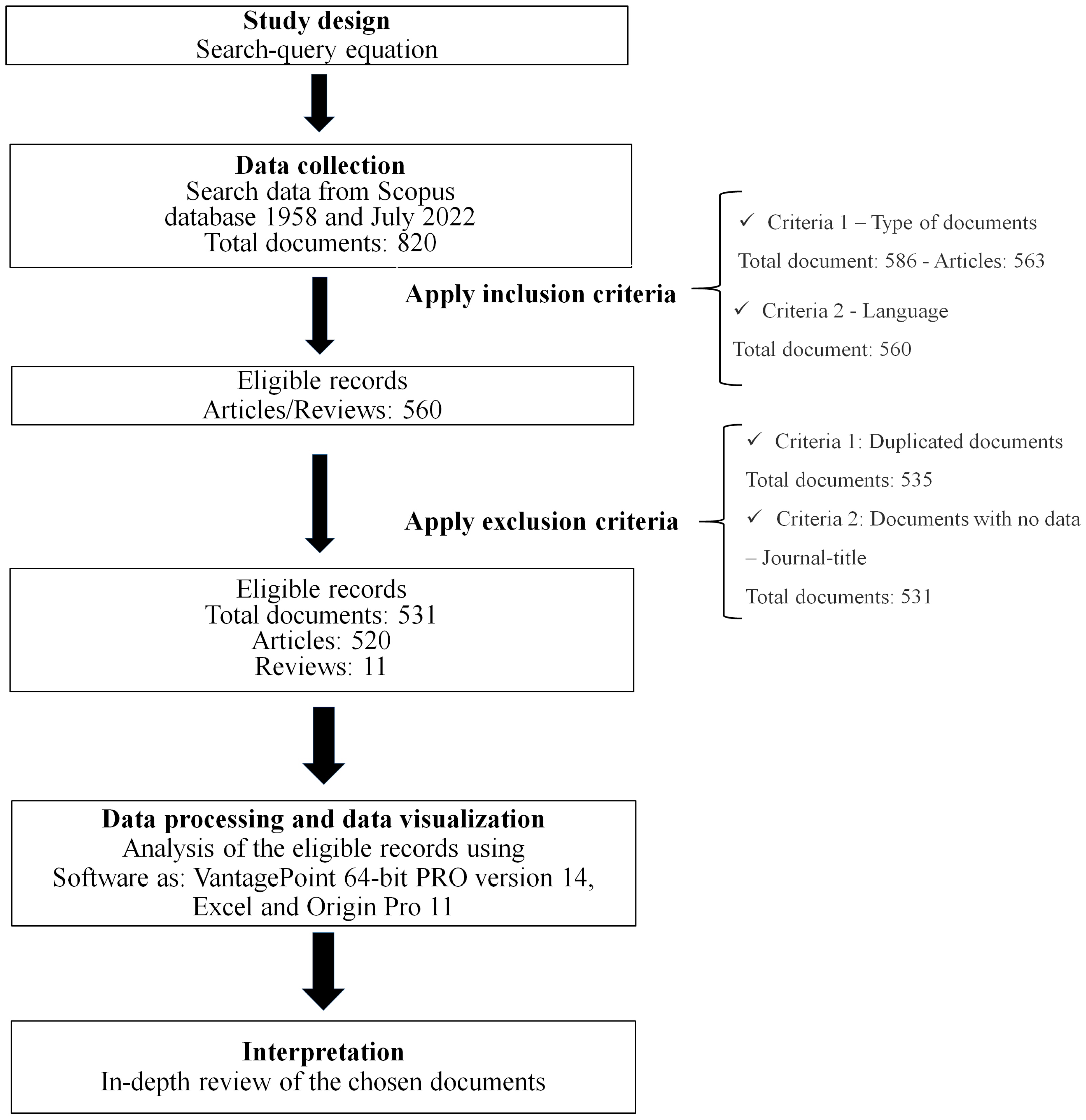

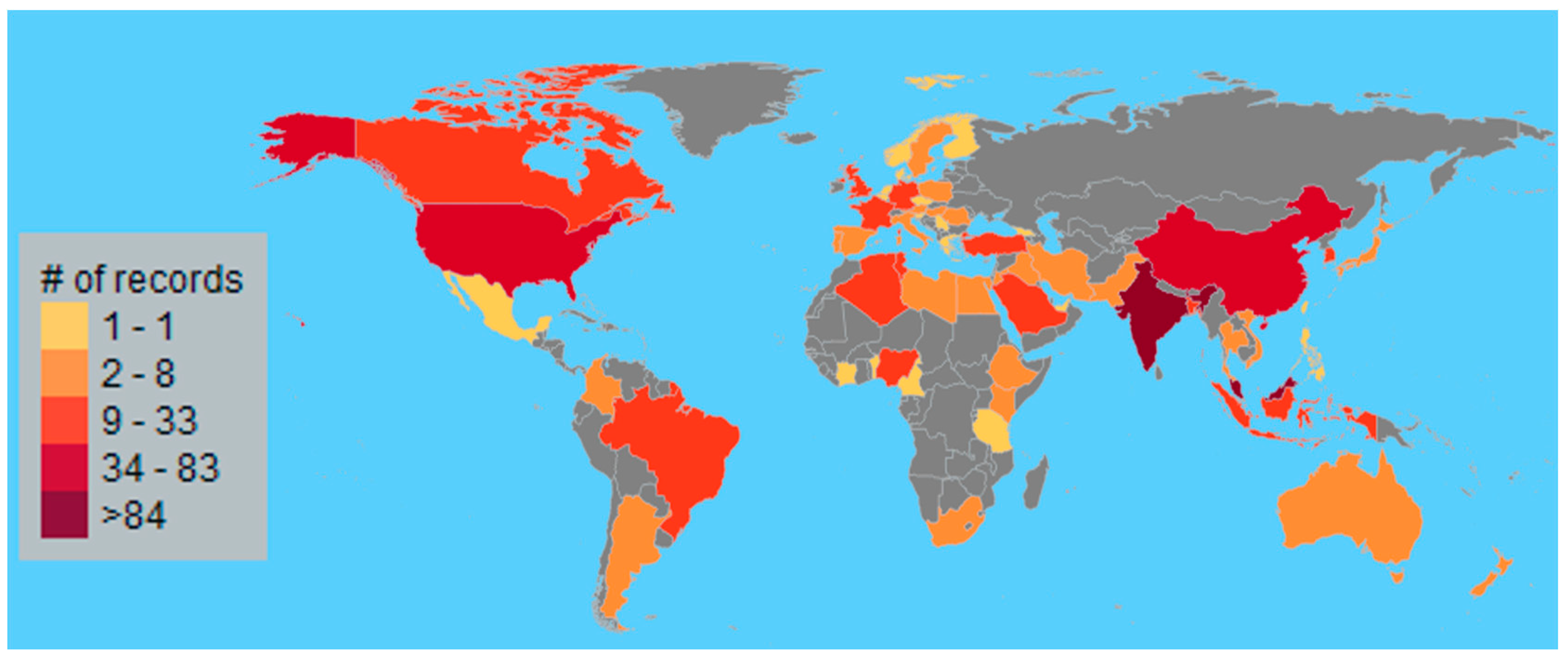
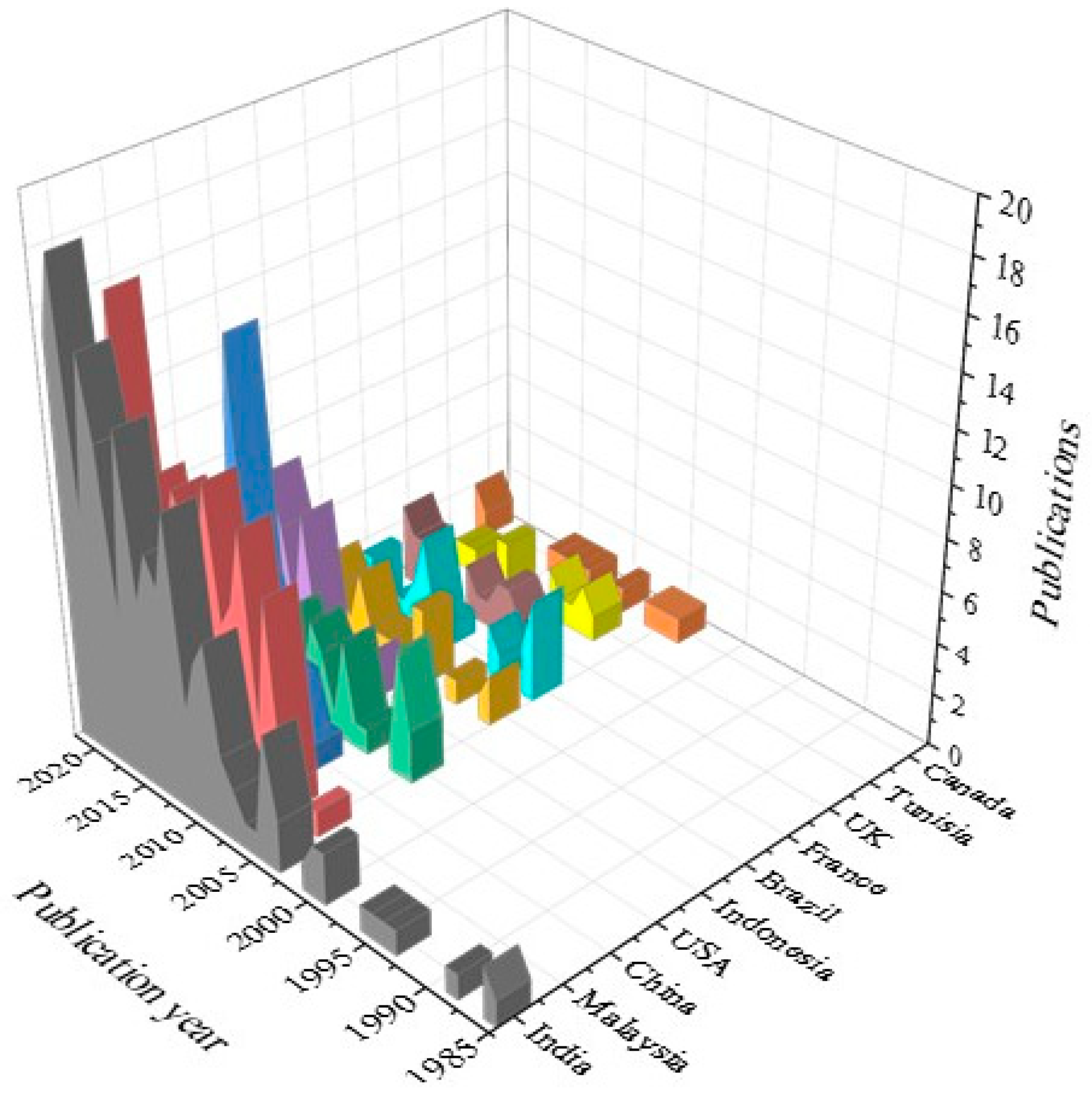
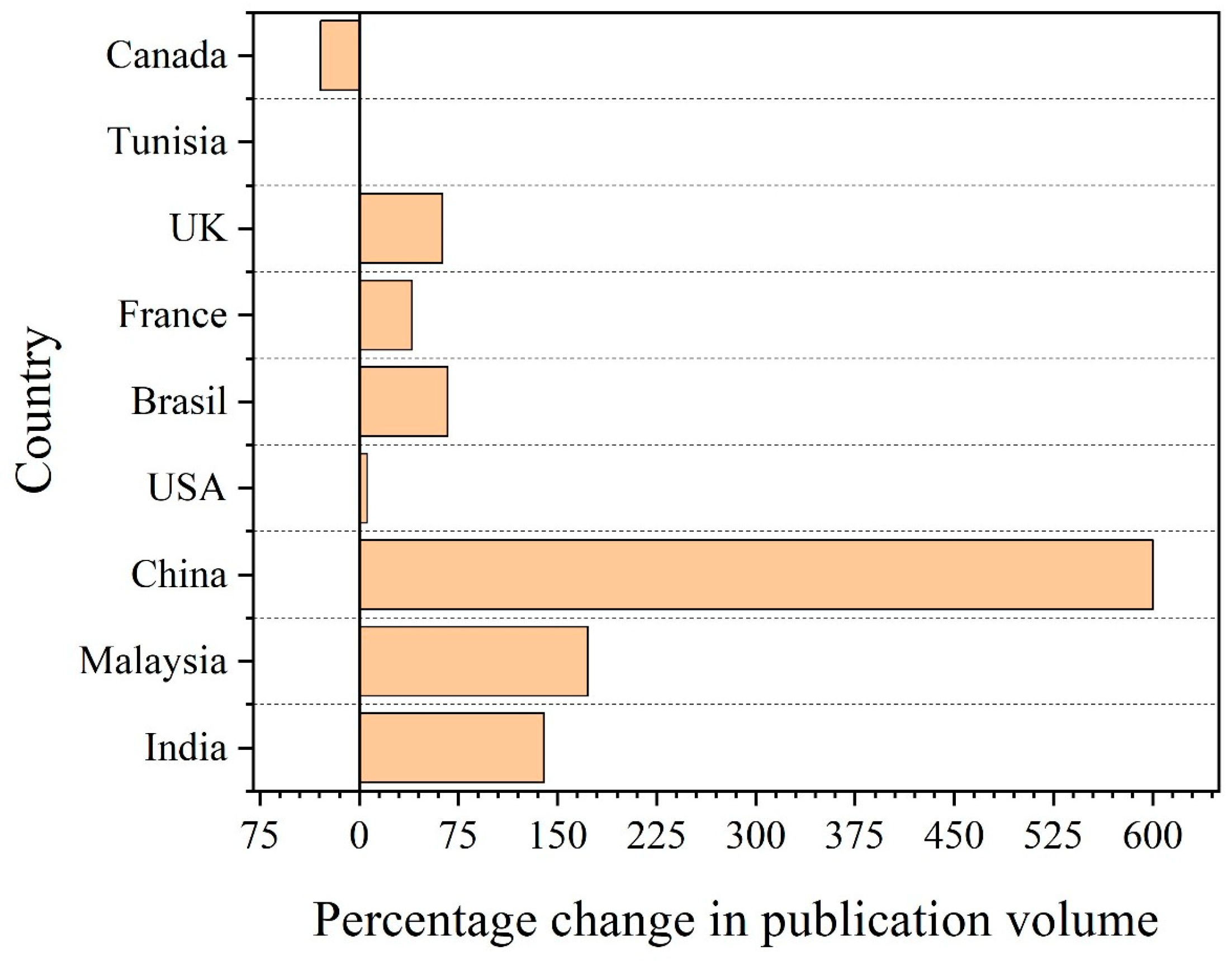
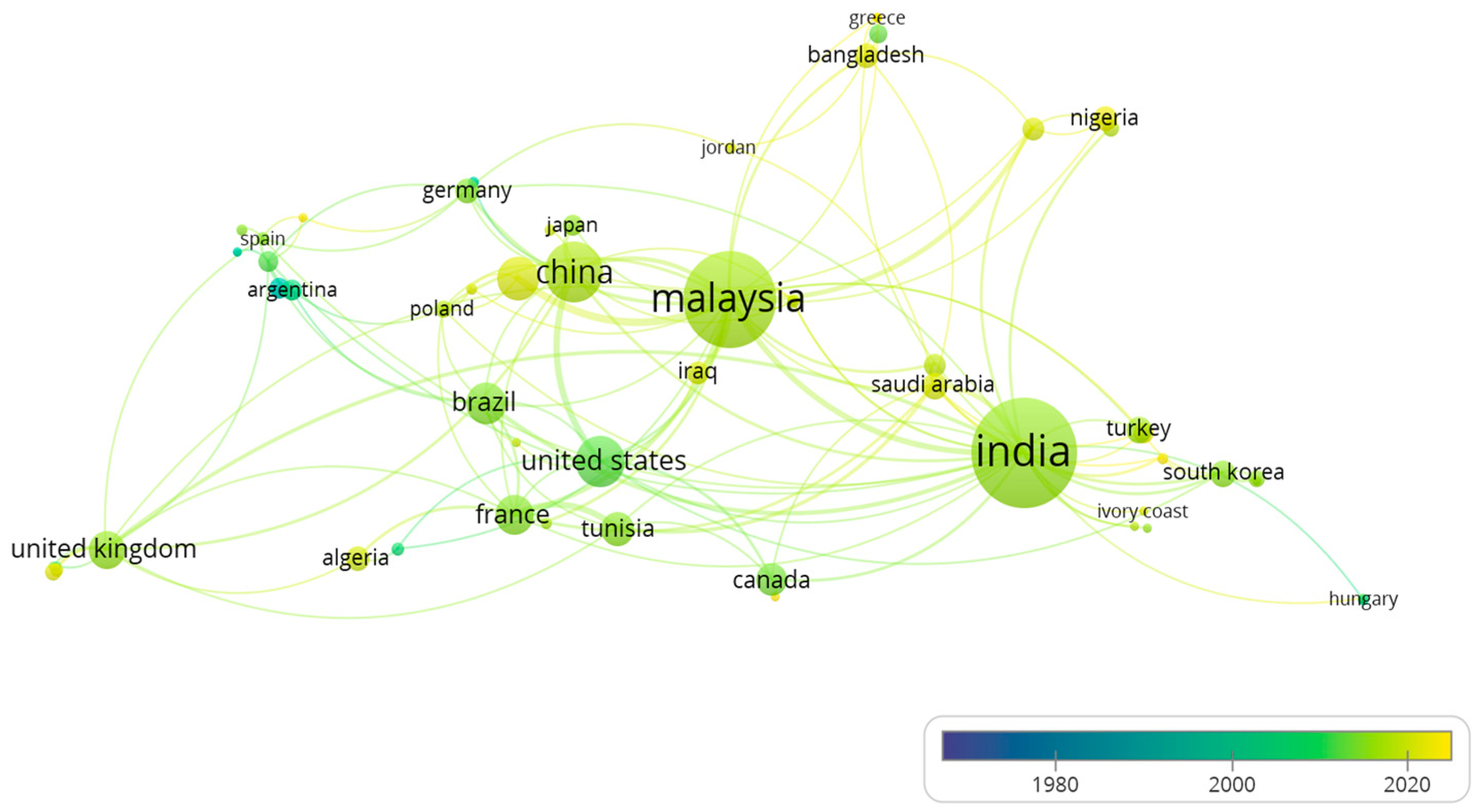

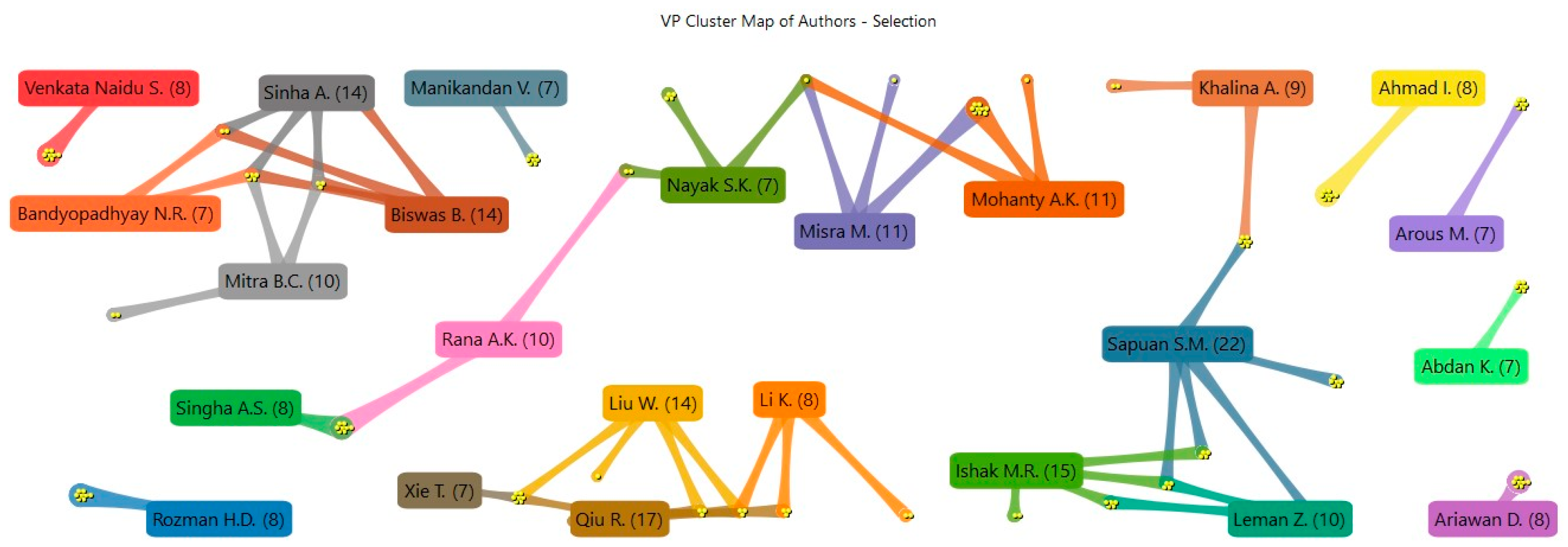
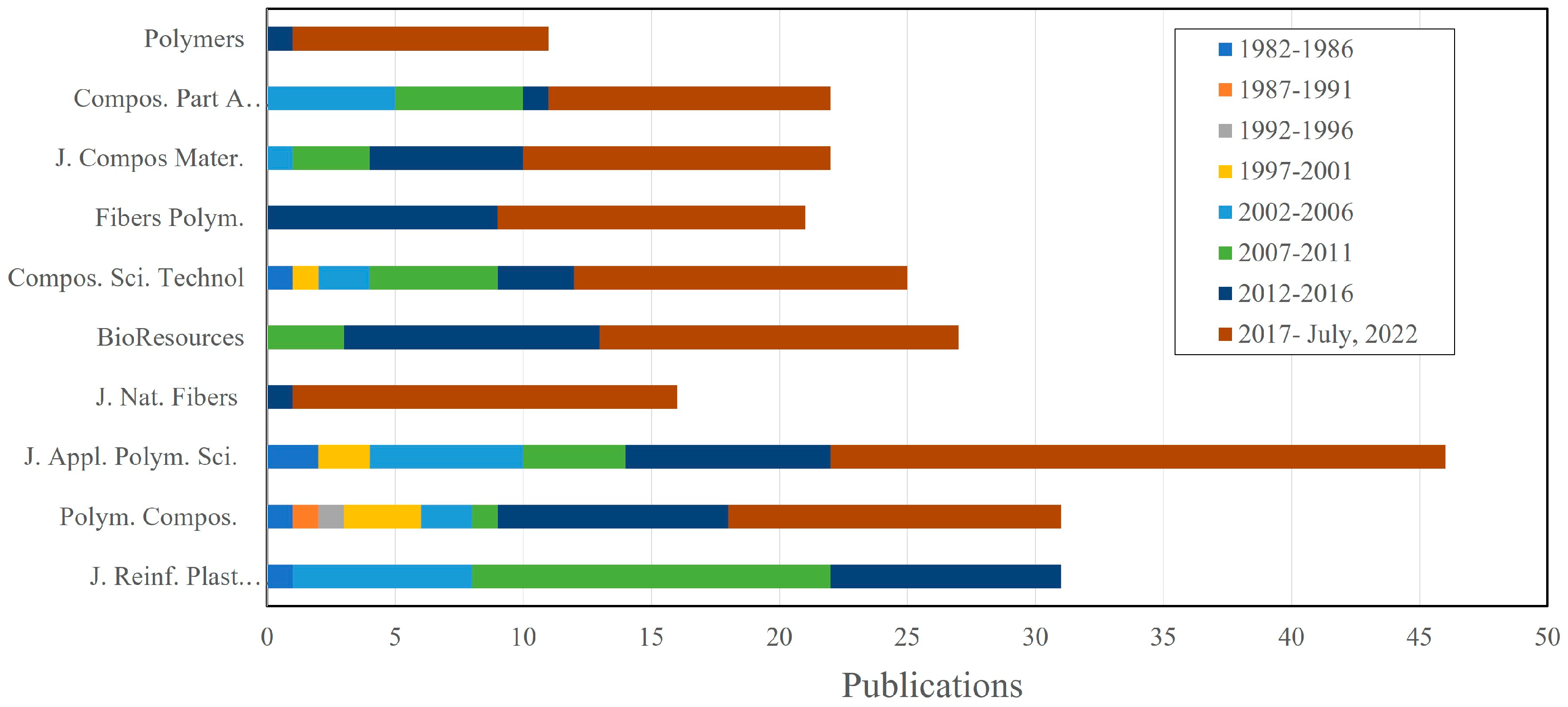
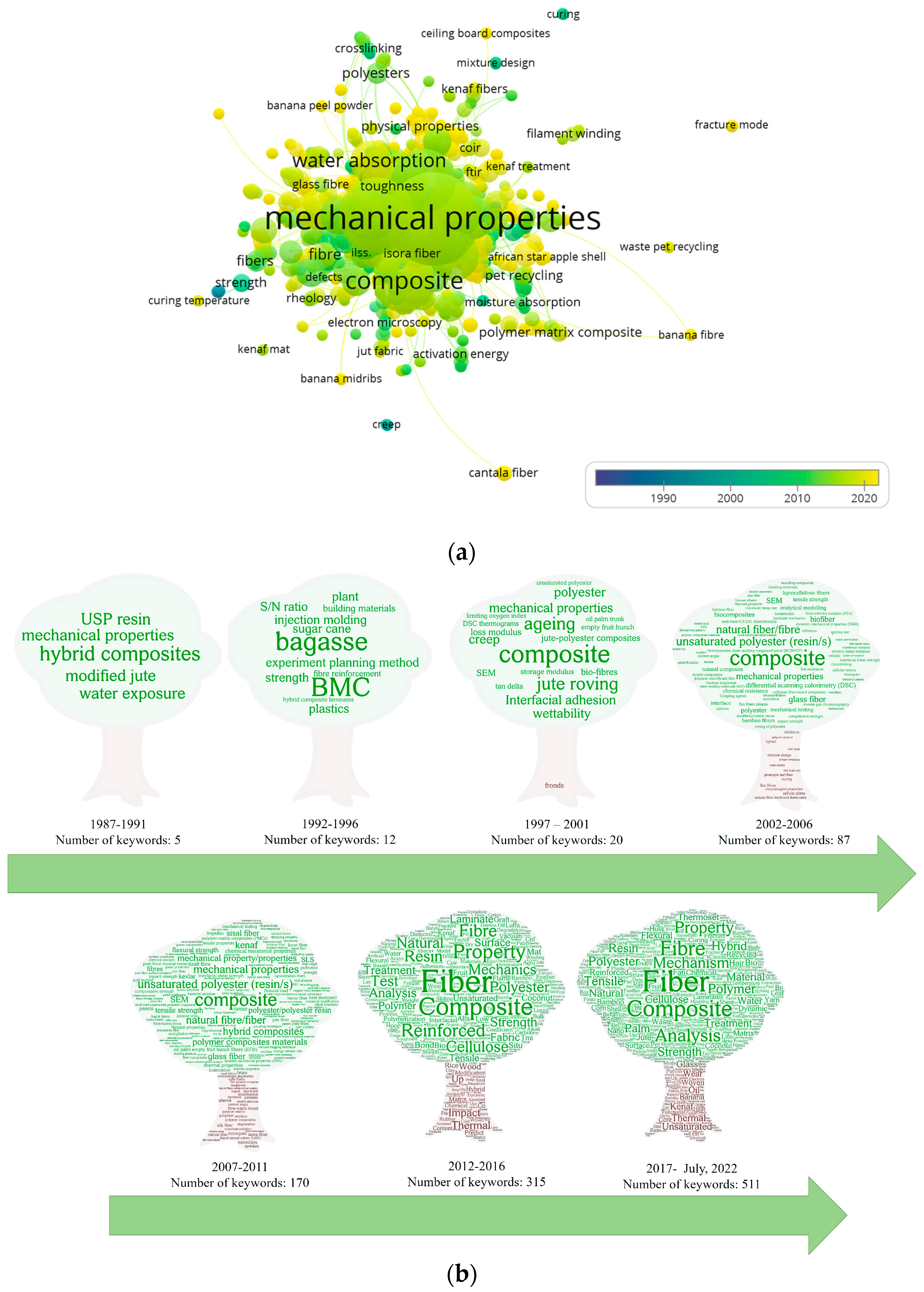

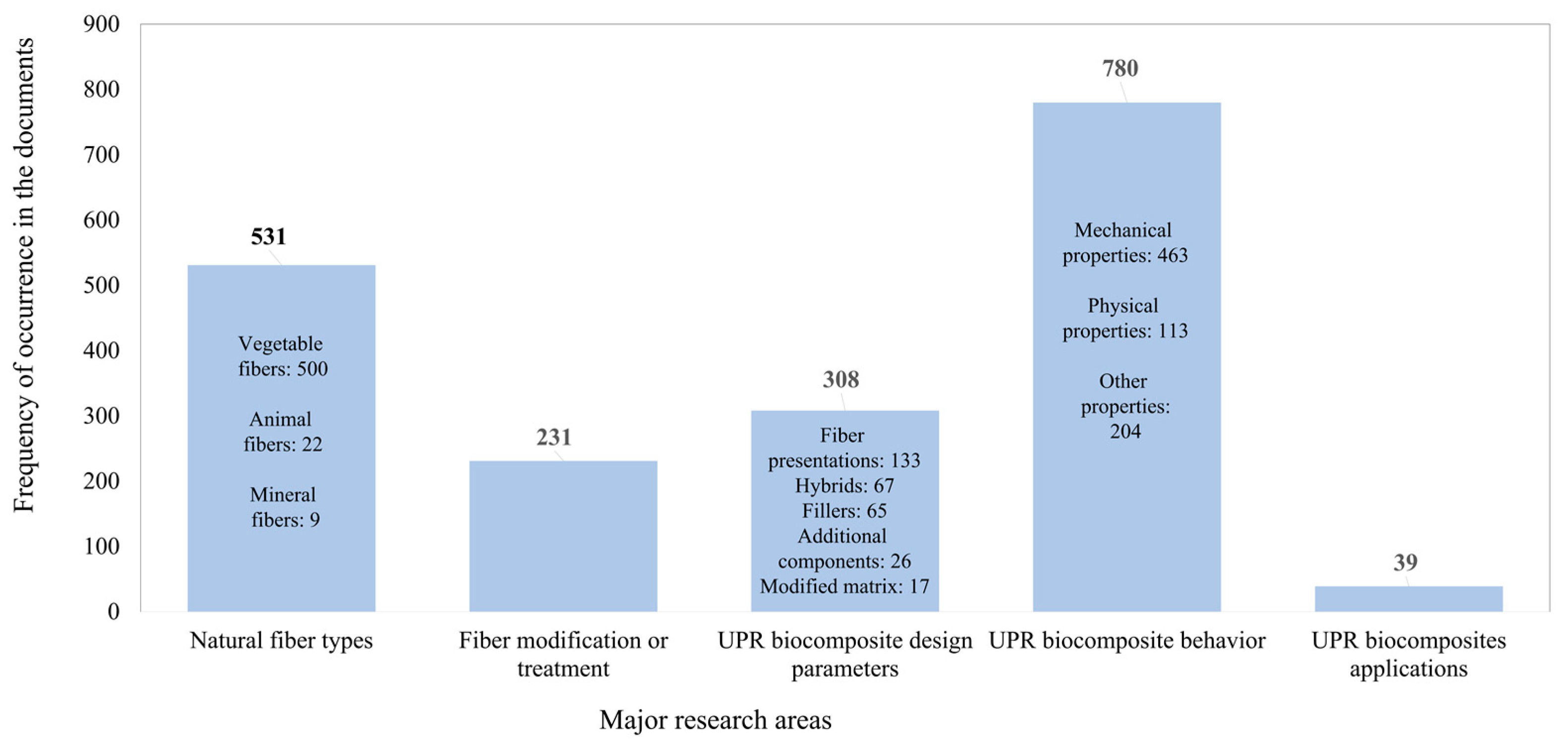

| Documents | Amount |
|---|---|
| Article | 563 |
| Conference paper | 191 |
| Book chapter | 24 |
| Review | 23 |
| Conference review | 18 |
| Data paper | 1 |
| Rank | State | Number of Publications | GDP Ranking in 2021 1 | Publications per Million Population (Equation (1)) | Publications per Capita Income Thousand USD (Equation (2)) |
|---|---|---|---|---|---|
| 1 | India | 168 | 6 | 1.21 × 10−4 | 7.38 |
| 2 | Malaysia | 130 | 37 | 4.00 × 10−3 | 1.14 |
| 3 | People’s R. of China | 52 | 2 | 3.70 × 10−5 | 0.08 |
| 4 | United States | 36 | 1 | 1.08 × 10−1 | 0.05 |
| 5 | Indonesia | 27 | 16 | 9.77 × 10−2 | 0.63 |
| 6 | Brazil | 25 | 12 | 1.17 × 10−1 | 0.33 |
| 7 | France | 23 | 7 | 3.41 × 10−3 | 0.05 |
| 8 | United Kingdom | 21 | 5 | 3.12 × 10−4 | 0.03 |
| 9 | Tunisia | 17 | 88 | 1.42 × 10−3 | 0.43 |
| 10 | Canada | 14 | 9 | 3.66 × 10−4 | 0.03 |
| 11 | Germany | 11 | 4 | 1.32 × 10−4 | 0.02 |
| 12 | Saudi Arabia | 10 | 18 | 2.83 × 10−4 | 0.04 |
| 13 | Korea, Rep. of | 10 | 10 | 1.93 × 10−4 | 0.03 |
| 14 | Turkey | 10 | 19 | 1.18 × 10−4 | 0.10 |
| 15 | Algeria | 9 | 57 | 2.02 × 10−4 | 0.24 |
| 16 | Bangladesh | 9 | 32 | 5.40 × 10−5 | 0.36 |
| 17 | Nigeria | 9 | 30 | 4.30 × 10−5 | 0.43 |
| 18 | Iraq | 8 | 52 | 1.94 × 10−4 | 0.16 |
| 19 | Australia | 7 | 13 | 2.72 × 10−4 | 0.01 |
| 20 | Egypt, Arab Rep. | 7 | 33 | 6.70 × 10−5 | 0.18 |
| 21 | Japan | 7 | 3 | 5.60 × 10−5 | 0.02 |
| 22 | Argentina | 6 | 26 | 1.31 × 10−4 | 0.06 |
| 23 | Ethiopia | 6 | 60 | 5.10 × 10−5 | 0.64 |
| 24 | Italy | 6 | 8 | 1.02 × 10−4 | 0.02 |
| 25 | Sweden | 6 | 22 | 5.76 × 10−4 | 0.01 |
| Rank | Authors | Paper Title | Year of Publication | Journal Title (Abbreviation 1) | Citations 2 |
|---|---|---|---|---|---|
| 1. | Mohanty A.K.; Misra M.; Hinrichsen G. | Biofibres, biodegradable polymers and biocomposites: An overview | 2000 | Macromolecular Materials and Engineering (Macromol. Mater. Eng.) | 2463 |
| 2 | Dhakal H.N.; Zhang Z.Y.; Richardson M.O.W. | Effect of water absorption on the mechanical properties of hemp fibre reinforced unsaturated polyester composites | 2007 | Composites Science and Technology (Compos. Sci. Technol.) | 1061 |
| 3 | Kargarzadeh H.; Mariano M.; Huang J.; Lin N.; Ahmad I.; Dufresne A.; Thomas S. | Recent developments on nanocellulose reinforced polymer nanocomposites: A review | 2017 | Polymer (Polymer) | 348 |
| 4 | Vilay V.; Mariatti M.; Mat Taib R.; Todo M. | Effect of fiber surface treatment and fiber loading on the properties of bagasse fiber-reinforced unsaturated polyester composites | 2008 | Composites Science and Technology (Compos. Sci. Technol.) | 291 |
| 5 | Manfredi L.B.; Rodríguez E.S.; Wladyka-Przybylak M.; Vázquez A. | Thermal degradation and fire resistance of unsaturated polyester, modified acrylic resins and their composites with natural fibres | 2006 | Polymer Degradation and Stability (Polym. Degrad. Stab.) | 267 |
| 6 | Athijayamani A.; Thiruchitrambalam M.; Natarajan U.; Pazhanivel B. | Effect of moisture absorption on the mechanical properties of randomly oriented natural fibers/polyester hybrid composite | 2009 | Materials Science and Engineering A (Mater. Sci. Eng. A) | 256 |
| 7 | Khalil H.P.S.A.; Ismail H.; Rozman H.D.; Ahmad M.N. | Effect of acetylation on interfacial shear strength between plant fibres and various matrices | 2001 | European Polymer Journal (Eur. Polym. J.) | 241 |
| 8 | Shanmugam D.; Thiruchitrambalam M. | Static and dynamic mechanical properties of alkali treated unidirectional continuous Palmyra Palm Leaf Stalk Fiber/jute fiber reinforced hybrid polyester composites | 2013 | Materials and Design (Mater. Des.) | 223 |
| 9 | Aziz S.H.; Ansell M.P.; Clarke S.J.; Panteny S.R. | Modified polyester resins for natural fibre composites | 2005 | Composites Science and Technology (Compos. Sci. Technol.) | 219 |
| 10 | Baley C.; Busnel F.; Grohens Y.; Sire O. | Influence of chemical treatments on surface properties and adhesion of flax fibre-polyester resin | 2006 | Composites Part A: Applied Science and Manufacturing (Compos. Part A Appl. Sci. Manuf.) | 206 |
| Rank | Journal Title Abbreviations 1 | Citations 2 | Total Papers | Cited Papers | CiteScore 2021 3 |
|---|---|---|---|---|---|
| 1 | Compos. Sci. Technol. | 2640 | 13 | 13 | 14.7 |
| 2 | Macromol. Mater. Eng. | 2480 | 3 | 2 | 6.2 |
| 3 | J. Reinf. Plast. Compos. | 1295 | 31 | 31 | 6.2 |
| 4 | J. Appl. Polym. Sci. | 1170 | 24 | 24 | 5.0 |
| 5 | Compos. Part A Appl. Sci. Manuf. | 1072 | 11 | 11 | 13.7 |
| 6 | Polym. Compos. | 1050 | 31 | 28 | 5.7 |
| 7 | Compos. B. Eng. | 582 | 8 | 7 | 18.6 |
| 8 | Mater. Des. | 558 | 7 | 7 | 13.2 |
| 9 | J. Compos Mater. | 469 | 12 | 12 | 4.7 |
| 10 | Mater. Sci. Eng. A | 438 | 3 | 3 | 9.4 |
Disclaimer/Publisher’s Note: The statements, opinions and data contained in all publications are solely those of the individual author(s) and contributor(s) and not of MDPI and/or the editor(s). MDPI and/or the editor(s) disclaim responsibility for any injury to people or property resulting from any ideas, methods, instructions or products referred to in the content. |
© 2023 by the authors. Licensee MDPI, Basel, Switzerland. This article is an open access article distributed under the terms and conditions of the Creative Commons Attribution (CC BY) license (https://creativecommons.org/licenses/by/4.0/).
Share and Cite
Gañán, P.; Barajas, J.; Zuluaga, R.; Castro, C.; Marín, D.; Tercjak, A.; Builes, D.H. The Evolution and Future Trends of Unsaturated Polyester Biocomposites: A Bibliometric Analysis. Polymers 2023, 15, 2970. https://doi.org/10.3390/polym15132970
Gañán P, Barajas J, Zuluaga R, Castro C, Marín D, Tercjak A, Builes DH. The Evolution and Future Trends of Unsaturated Polyester Biocomposites: A Bibliometric Analysis. Polymers. 2023; 15(13):2970. https://doi.org/10.3390/polym15132970
Chicago/Turabian StyleGañán, Piedad, Jaime Barajas, Robin Zuluaga, Cristina Castro, Daniel Marín, Agnieszka Tercjak, and Daniel H. Builes. 2023. "The Evolution and Future Trends of Unsaturated Polyester Biocomposites: A Bibliometric Analysis" Polymers 15, no. 13: 2970. https://doi.org/10.3390/polym15132970
APA StyleGañán, P., Barajas, J., Zuluaga, R., Castro, C., Marín, D., Tercjak, A., & Builes, D. H. (2023). The Evolution and Future Trends of Unsaturated Polyester Biocomposites: A Bibliometric Analysis. Polymers, 15(13), 2970. https://doi.org/10.3390/polym15132970










